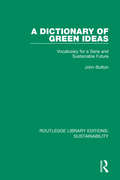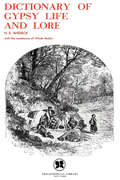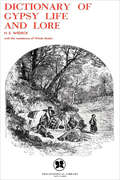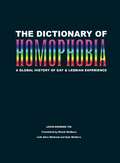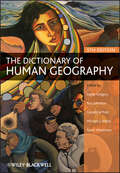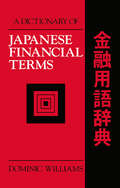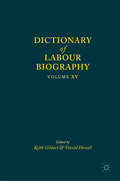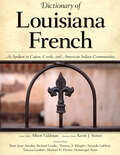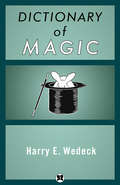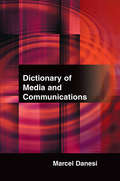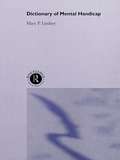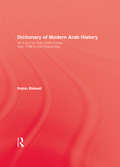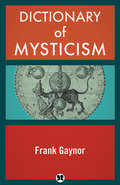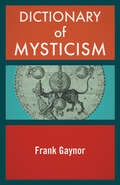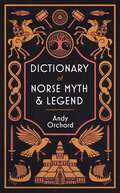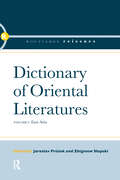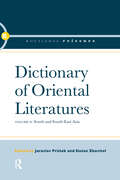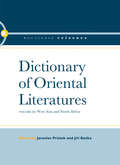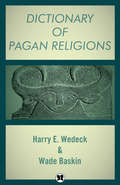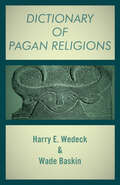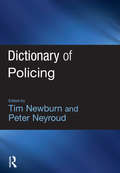- Table View
- List View
A Dictionary of Green Ideas: Vocabulary for a Sane and Sustainable Future (Routledge Library Editions: Sustainability #1)
by John ButtonFirst published in 1988. A Dictionary of Green Ideas collects together the concepts which go to make up a green view of the world. Ecology and the environment, conservation and appropriate technology, politics and philosophy, peace and health, spirituality and world development - all these areas and more are reflected in nearly 1500 entries. The entries range from the very short to full-length essays, reflecting the diversity of the subject matter. All give a clear definition of the meaning of the term and an indication of its etymology and earliest use. But the Dictionary of Green Ideas is much more than simply a list of definitions. The concepts discussed are elaborated upon, interpreted, set in context, exemplified by quotations from a wide range of sources, and related to other entries by means of an extensive network of cross-references. The result is a fascinating and immensely readable book which successfully fulfils a double role as an accessible introduction to green thought, and as a source of reference offering new insights to green thinkers of long standing.
Dictionary of Gypsy Life and Lore
by Wade Baskin Harry E WedeckThrough the centuries, Gypsies all over the world have been misunderstood, maligned, rejected. Outcasts of the countries in which they live, they have wandered for centuries over the face of the earth. They have no homeland, no political unity, no recognition among nations. They have been alone, sundered, shunned, persecuted and banished. Until about a century ago, their original home had been a matter of dispute. Their language had been a source of puzzlement. Yet their conduct and their traditions, their feeling for music, dance and song, have all been acclaimed. Still they were not accepted and were forced to remain apart from conventional society. Here is their epic history, with its folktales and beliefs, its rites and customs. Here is the vast treasury of the Gypsies.
Dictionary of Gypsy Life and Lore
by Harry E. Wedeck Wade BaskinThis comprehensive reference volume offers in-depth information on one of the world&’s most fascinating and misunderstood cultures. Throughout history, Gypsies all over the world have been maligned and rejected. Outcasts of the countries in which they live, these nomads have wandered for years over the face of the earth. They have no homeland, no political unity, no recognition among nations. In popular folklore, they are vagrants, thieves, tinkerers, and con artists, which is to say, egregiously misunderstood. Until about a century ago, these travelers&’ original home had been a matter of dispute. Their language had been a source of puzzlement. Yet their conduct and their traditions, their feeling for music, dance and song, have all been acclaimed. Harry Wedeck&’s Dictionary of Gypsy Life and Lore sheds much-needed light on the true history and culture of the Gypsies, separating fact from fiction while celebrating their folktales, rites, and customs.
Dictionary of Gypsy Mythology: Charms, Rites, and Magical Traditions of the Roma
by Claude LecouteuxA comprehensive A-to-Z reconstruction of the oral tradition of the Rom--gypsies--based on sources never before available in English • Presents the origin myths and magical traditions of the gypsies, including their legendary ties to Egypt, animal ancestors, and tree spirits • Examines the three major settings of gypsy folktales--the forest, the waters, and the mountain--and shows how their world is full of spirits • Shows how the religious concepts of the Rom testify to a profound syncretism of the pagan traditions and Christianity Although their own myths and their common name point to Egyptian origins for the gypsies, the Rom, as they call themselves, originated in India, as evidenced by studies of their language. They arrived in Europe in the ninth century and spread across the continent from East to West, reaching England in the 15th century and Scandinavia by the end of the 16th century. A nomadic people, these wanderers were reviled by local populaces wherever they went and regarded as misfits, intruders, foreigners, and thieves. Drawing on a number of sources never before available outside of Eastern Europe, Claude Lecouteux reconstructs the gypsy oral tradition to provide a comprehensive A-to-Z look at gypsy mythology, including their folktales, rites, songs, nursery rhymes, jokes, and magical traditions. His main source is material collected by Heinrich Adalbert von Wlislocki (1856-1907), an ethnologist who lived with gypsies in Romania, Transylvania, and Hungary in the latter half of the 19th century. He presents the origin myths of the gypsies, legends which form the ancestral memory of the gypsy tribes and often closely touch on their daily life. Lecouteux explores the full range of supernatural beings that inhabit the gypsy world, including fairies, undines, ogres, giants, dog-people, and demons, and he examines the three major settings of gypsy folktales--the forest, the waters, and the mountain, which they worshiped as a sacred being in its own right. He also reveals how coexisting with peoples of different religions led the gypsies to adapt or borrow stories and figures from these groups, and he shows how the religious concepts and sacred stories of the Rom testify to a profound syncretism of pagan traditions and Christianity. Complete with rare illustrations and information from obscure sources appearing for the first time in English, this detailed reference work represents an excellent resource for scholars and those seeking to reconnect to their forgotten gypsy heritage.
The Dictionary of Homophobia: A Global History of Gay & Lesbian Experience
by Louis-Georges Tin Marek RedburnBased on the work of seventy researchers in fifteen countries, The Dictionary of Homophobia is a mammoth, encyclopedic book that documents the history of homosexuality, and various cultural responses to it, in all regions of the world: a masterful, engaged, and wholly relevant study that traces the political and social emancipation of a culture.<P> The book is the first English translation of Dictionnaire de L’Homophobie, published in France in 2003 to worldwide acclaim; its editor, Louis-Georges Tin, launched the first International Day Against Homophobia in 2005, now celebrated in more than fifty countries around the world. The Dictionary of Homophobia includes over 175 essays on various aspects of gay rights and homophobia as experienced in all regions in Africa, the Americas, Asia, Europe, and the South Pacific, from the earliest epochs to present day.<P> Subjects include religious and ideological forces such as the Bible, Communism, Judaism, Hinduism, and Islam; historical subjects, events, and personalities such as AIDS, Stonewall, J. Edgar Hoover, Matthew Shepard, Oscar Wilde, Pat Buchanan, Joseph McCarthy, Pope John Paul II, and Anita Bryant; and other topics such as coming out, adoption, deportation, ex-gays, lesbiphobia, and bi-phobia. In a world where gay marriage remains a hot-button political issue, and where adults and even teens are still being executed by authorities for the “crime” of homosexuality, The Dictionary of Homophobia is a both a revealing and necessary history lesson for us all.
The Dictionary of Human Geography
by Ron Johnston Geraldine Pratt Sarah Whatmore Derek Gregory Michael WattsWith clear, critical, and constructive surveys of key terms by leading researchers in the field, The Dictionary of Human Geography, fifth edition, remains the definitive guide to the concepts and debates in human geography. Comprehensively revised new edition of a highly successful text with over 300 key terms appearing for the first timeSituates Human Geography within the humanities, social sciences and sciences as a wholeWritten by leading experts in the fieldMajor entries not only describe the development of concepts, contributions and debates in Human Geography but also advance themFeatures a new consolidated bibliography along with a detailed index and systematic cross-referencing of headwords
Dictionary of Islamic Architecture
by Andrew PetersenThe Dictionary of Islamic Architecture provides the fullest range of artistic, technical, archaeological, cultural and biographical data for the entire geographical and chronological spread of Islamic architecture - from West Africa through the Middle East to Indonesia, and from the seventh to the eighteenth centuries of the Common Era.Over 500 entries are arranged alphabetically and fully cross-referenced and indexed to permit easy access to the text and to link items of related interest.Four main categories of subject matter are explored:* dynastic and regional overviews* individual site descriptions* biographical entries* technical definitionsOver 100 relevant plans, sketch maps, photographs and other illustrations complement and illuminate the entries, and the needs of the reader requiring further information are met by individual entry bibliographies.
A Dictionary of Japanese Financial Terms
by Dominic WilliamsA comprehensive and easy-to-use dictionary for each item listing its romaji (phonetic English) and kanji spellings and its English equivalent.
A Dictionary of Kanien’kéha (Mohawk) with Connections to the Past
by Karin Michelson Gunther Michelson Glenda Canadian DeerThis dictionary provides a record of the Kanien’kéha (Mohawk) language as spoken by fluent first- and second-language speakers at the Kanien’kéha Mohawk Territory outside of Montréal, Canada. The Kanien’kéha language has been written since the 1600s, and these dictionary entries include citations from published, archival, and informal writings from the seventeenth century onwards. These citations are a legacy of the substantial documents of missionary scholars and several informal vocabulary lists written by Kanien’kéha speakers, among others. The introduction to the dictionary provides a description of the organization and orthography of the historical works so that they can be used in the future by those studying and learning the language. A Dictionary of Kanien’kéha (Mohawk) with Connections to the Past allows scholars and students to learn the meaning, composition, and etymology of words in a language known for its particularly complex word structure. The organization of the entries, according to noun and verb roots, highlights the remarkable potential and adaptability of the language to express traditional concepts, as well as innovations that have resulted from contact with other customs and languages that have become part of the contemporary culture of the Kanien’kehá:ka.
Dictionary of Labour Biography: Volume XV
by David Howell Keith GildartThe Dictionary of Labour Biography has an outstanding reputation as a reference work for the study of nineteenth and twentieth century British history. Volume XV maintains this standard of original and thorough scholarship. Each entry is written by a specialist drawing on an array of primary and secondary sources. The biographical essays engage with recent historiographical developments in the field of labour history. The scope of the volume emphasises the ethnic and national diversity of the British labour movement and neglected political traditions.
Dictionary of Louisiana French: As Spoken in Cajun, Creole, and American Indian Communities
by Barry Jean Ancelet Richard Guidry Thomas A. Klingler Amanda LaFleur Tamara Lindner Michael D. Picone Dominique RyonThe Dictionary of Louisiana French (DLF) provides the richest inventory of French vocabulary in Louisiana and reflects precisely the speech of the period from 1930 to the present. This dictionary describes the current usage of French-speaking peoples in the five broad regions of South Louisiana: the coastal marshes, the banks of the Mississippi River, the central area, the north, and the western prairie. Data were collected during interviews from at least five persons in each of twenty-four areas in these regions. In addition to the data collected from fieldwork, the dictionary contains material compiled from existing lexical inventories, from texts published after 1930, and from archival recordings. The new authoritative resource, the DLF not only contains the largest number of words and expressions but also provides the most complete information available for each entry. Entries include the word in the conventional French spelling, the pronunciation (including attested variants), the part of speech classification, the English equivalent, and the word's use in common phrases. The DLF features a wealth of illustrative examples derived from fieldwork and textual sources and identification of the parish where the entry was collected or the source from which it was compiled. An English-to-Louisiana French index enables readers to find out how particular notions would be expressed in la Louisiane.
Dictionary of Magic
by Harry E WedeckDictionary of Magic by Harry E. Wedeck offers a broad understanding of the field of witchcraft, the occult, and its many manifestations, from early Babylonian times to the present day. It includes knowledge of words in this area from many continents and practices. It also discusses and analyzes occult practices and notable wizards and demographers.
Dictionary of Media and Communications (Toronto Studies In Semiotics And Communication Ser.)
by Marcel DanesiAccessible to wide range of readers from student to lay people, this authoritative reference provides a complete listing of media concepts, figures, and techniques with illustrations and historical commentaries. Written by distinguished scholar and author Marcel Danesi, and with an Introduction by Arthur Asa Berger, a leading figure in the world of media and communications, the dictionary also includes terms related to psychology, linguistics, aesthetics, computer science, semiotics, culture theory, anthropology, and more that have relevance in media studies. Each entry includes a definition in simple, clear language; an illustration where applicable; and, historical commentary (who coined a term for example, why, who uses it, etc.). A bibliography, a directory of online resources, and a time-line of media genres add to the dictionary's usefulness and appeal.
Dictionary of Mental Handicap
by Mary P. LindseyFirst published in 2002. Routledge is an imprint of Taylor & Francis, an informa company.
Dictionary Of Modern Arab Histor
by BidwellFrom 1980 until Dr. Bidwell's death in 1994, much of his time was taken up with the writing and compilation of this encyclopaedic work which represents, in the true sense of the word, a unique account of the Arab world from 1798 and a readable assessment of all its aspects. Whereas the classical period is covered in many publications, notably "The Encyclopaedia of Islam", the reader look up assessments and accounts of 14 presidents of modern Syria; all prime ministers of Egypt; the definition and effect of "Resolution 242"; the Istiqlal Party; the Rogers Plan; Saddam Hussein; Dair Yassin; the Agecirus Conference; the Mecca Declaration; the Black September Organization; President Nimeiri; the monarchs of Egypt, Iraq and Libya; King Khalid of Saudi Arabia; Colonel Gaddafi; Nasser; the Battle of Mehran; Count Folke Bernadotte; the massacre of the Mamluks; and President Bourguiba.
Dictionary of Mysticism
by Frank GaynorThis dictionary provides concise definitions for over 2200 terms used in many philosophies, religions and doctrines which relate to the influence of the superhuman and supernatural on man's everyday life. Terms which are found in Esoteric Philosophy, Occultism, Religious Mysticism, Spiritualism, Alchemy, Psychical Research, and Religious Mysticism are defined. Particular attention is given to the Oriental philosophies of Buddhism, Brahmanism, Sufism, Lamaism, Zoroastrianism, Theosophy, and Cabbalism. Also included are terms used in Magic and Demonology.
Dictionary of Mysticism: Dictionary Of Mysticism, Encyclopedia Of Superstitions, And Dictionary Of Magic
by Frank GaynorMore than 2,200 terms defined in an essential reference on religious mysticism, esoteric philosophy, occultism, and more. Dictionary of Mysticism provides concise definitions for more than 2,200 terms used in many philosophies, religions, and doctrines which relate to the influence of the superhuman and supernatural on man&’s everyday life. Terms relating to esoteric philosophy, occultism, religious mysticism, spiritualism, alchemy, and psychical research are defined. Particular attention is given to the Eastern philosophies of Buddhism, Brahmanism, Sufism, Lamaism, Zoroastrianism, Theosophy, and Cabbalism. Also included are terms used in magic and demonology.
Dictionary of Norse Myth & Legend
by Andrew OrchardFrom Loki to Thor, Ragnarok to BeowulfA gripping and truly mesmerising delve into the Norse legendsFrom bestselling books to blockbusting Hollywood movies, the myths of the Scandinavian gods and heroes are part of the modern day landscape.For over a millennium before the arrival of Christianity, the legends permeated everyday life in Iceland and the northern reaches of Europe. Since that time, they have been perpetuated in literature and the arts in forms as diverse as Tolkien and Wagner, graphic novels to the world of Marvel. This book covers the entire cast of supernatural beings, from gods to trolls, heroes to monsters, and deals with the social and historical background to the myths, topics such as burial rites, sacrificial practices and runes.
Dictionary of Norse Myth & Legend
by Andrew OrchardFrom Loki to Thor, Ragnarok to BeowulfA gripping and truly mesmerising delve into the Norse legendsFrom bestselling books to blockbusting Hollywood movies, the myths of the Scandinavian gods and heroes are part of the modern day landscape.For over a millennium before the arrival of Christianity, the legends permeated everyday life in Iceland and the northern reaches of Europe. Since that time, they have been perpetuated in literature and the arts in forms as diverse as Tolkien and Wagner, graphic novels to the world of Marvel. This book covers the entire cast of supernatural beings, from gods to trolls, heroes to monsters, and deals with the social and historical background to the myths, topics such as burial rites, sacrificial practices and runes.
Dictionary of Oriental Literatures 1: East Asia
by Jaroslav Průšek Zbigniew SłupskiThe Dictionary of Oriental Literatures fills a long-felt gap in Western literature by presenting a concise summary, in three volumes and about 2000 articles, of practically all the literatures of Asia and North Africa. The first volume describes the Chinese, Tibetan, Japanese, Korean and Mongolian literatures; the second covers the area of South and South-East Asia, comprising, besides all literatures of India and Pakistan, those of Nepal, Bangladesh, Sri Lanka, Myanmar, Thailand, Cambodia, Vietnam, Indonesia, Malaysia and the Philippines; and the third is devoted to the numerous literatures of West Asia and North Africa. including on the one hand the literatures of the ancient Near East and Egypt, and on the other hand those of Central Asia and the Caucasus, of Turkey, Iran, Afghanistan and of the various Arab countries including Morocco, Tunisia and Algeria. The majority of entries give information about the life and work of the individual writers and poets of the classical, medieval and modern periods of the literatures included and also attempt to evaluate their writings from the historical and aesthetic point of view. The remaining articles describe literary terms, genres, forms, schools, movements etc. The Dictionary has been prepared by the Oriental Institute in Prague under the supervision of a Advisory Editorial Board of European and American scholars of international reputation and is unique in that it is the fruit of the collaboration of over 150 orientalists from many parts of the world. Contents include: Volume I East Asia: The Far East, including Chinese, Tibetan, Japanese, Korean and Mongolian literatures. Volume II South and South-East Asia: Ancient Indian, Assamese, Baluchi, Bengali, Gujarati, Hindi, Indian literature in English, Indo-Persian, Kannada, Kashmiri, Maithili, Malayalam, Marathi, Oriya, Panjabi, Pashto, Rajasthani, Sindhi, Tamil, Telugu and Urdu, Sinhalese, Nepali, Burmese, Thai, Cambodian, Malay and Indonesian, Javanese, Vietnamese and Philippines literatures. Volume III West Asia and North Africa: The Near East and Egypt, Central Asia and the Caucasus, Turkish, Persian, Afghan, Kurd and Arabic literatures, covering all the Arab states from Iraq in the East to Algeria in the West.
Dictionary of Oriental Literatures 2: South and SE Asia
by Jaroslav Pru̇šek Dušan ZbavitelThis book fills a long-felt gap in Western literature by presenting a concise summary of practically all the literatures of South and South-East Asia, comprising India, Pakistan, Nepal, Bangladesh, Sri Lanka, Myanmar, Thailand, Combodia, Vietnam, Indonesia, Malaysia, and the Philippines.
Dictionary of Oriental Literatures 3: West Asia and North Africa
by Jaroslav Průšek Jirí BeckaThe Dictionary of Oriental Literatures fills a long-felt gap in Western literature by presenting a concise summary, in three volumes and about 2000 articles, of practically all the literatures of Asia and North Africa. The first volume describes the Chinese, Tibetan, Japanese, Korean and Mongolian literatures; the second covers the area of South and South-East Asia, comprising, besides all literatures of India and Pakistan, those of Nepal, Bangladesh, Sri Lanka, Myanmar, Thailand, Cambodia, Vietnam, Indonesia, Malaysia and the Philippines; and the third is devoted to the numerous literatures of West Asia and North Africa. including on the one hand the literatures of the ancient Near East and Egypt, and on the other hand those of Central Asia and the Caucasus, of Turkey, Iran, Afghanistan and of the various Arab countries including Morocco, Tunisia and Algeria. The majority of entries give information about the life and work of the individual writers and poets of the classical, medieval and modern periods of the literatures included and also attempt to evaluate their writings from the historical and aesthetic point of view. The remaining articles describe literary terms, genres, forms, schools, movements etc. The Dictionary has been prepared by the Oriental Institute in Prague under the supervision of a Advisory Editorial Board of European and American scholars of international reputation and is unique in that it is the fruit of the collaboration of over 150 orientalists from many parts of the world. Contents include: Volume I East Asia: The Far East, including Chinese, Tibetan, Japanese, Korean and Mongolian literatures. Volume II South and South-East Asia: Ancient Indian, Assamese, Baluchi, Bengali, Gujarati, Hindi, Indian literature in English, Indo-Persian, Kannada, Kashmiri, Maithili, Malayalam, Marathi, Oriya, Panjabi, Pashto, Rajasthani, Sindhi, Tamil, Telugu and Urdu, Sinhalese, Nepali, Burmese, Thai, Cambodian, Malay and Indonesian, Javanese, Vietnamese and Philippines literatures. Volume III West Asia and North Africa: The Near East and Egypt, Central Asia and the Caucasus, Turkish, Persian, Afghan, Kurd and Arabic literatures, covering all the Arab states from Iraq in the East to Algeria in the West.
Dictionary of Pagan Religions
by Wade Baskin Harry E WedeckAssembled here for the first time in one volume are the essential facts about the cults, rites and rituals associated with polytheistic religions that have existed from the Stone Age to the present. The aim of the book is to create and preserve a partial record of the pagan religions or cults that have flourished since the dawn of mankind and of their impact and influence throughout the world. This record includes many of the forgotten religions and their ideologies, practices, and mythologies.
Dictionary of Pagan Religions: Dictionary Of Satanism, Dictionary Of Witchcraft, And Dictionary Of Pagan Religions
by Harry E. Wedeck Wade BaskinA comprehensive reference guide to religious cults of the ancient world, with essential information on religious systems, texts, temple sites, and more. Dictionary of Pagan Religions offers a wide-ranging survey of the many religious cults that have flourished around the world from the Stone Age to the present. From Egyptian to Celtic traditions, and Gnosticism to Cabala, coauthors Harry E. Wedeck and Wade Baskin have compiled in-depth information about the rites and rituals associated with these religious systems, as well as their surprisingly significant influence on mainstream theology and philosophy. This authoritative text includes many of the world&’s forgotten religions, with important information about their ideologies, practices, mythologies, and more. Arranged in A-to-Z format, Dictionary of Pagan Religions is an essential reference guide for any student of paganism, polytheism, or ancient religious practices.
Dictionary of Policing
by Tim Newburn Peter NeyroudContemporary policing is developing rapidly and is becoming increasingly professionalized. For practitioners National Occupational Standards, Skills for Justice and the the new PDLP (Police Development and Leaning Programme) have brought a new emphasis on skills, standards and knowledge. Training for police officers and civilian staff working in policing is being significantly upgraded. At the same time it has become more rigorous, with universities and other higher educational institutions playing an increasingly important part in police training - as well as expanding the range of policing courses for undergraduate and postgraduate students.Key features: approximately 300 entries (of between 500 and 1500 words) on key terms and concepts arranged alphabetically designed to meet the needs of both students and practitioners entries include summary definition, main text and key texts and sources takes full account of emerging occupational and Skills for Justice criteria edited by the UK's leading academic expert on policing and the Chief Executive of the National Policing Improvement Agency Entries contributed by leading academic and practitioners in policing
